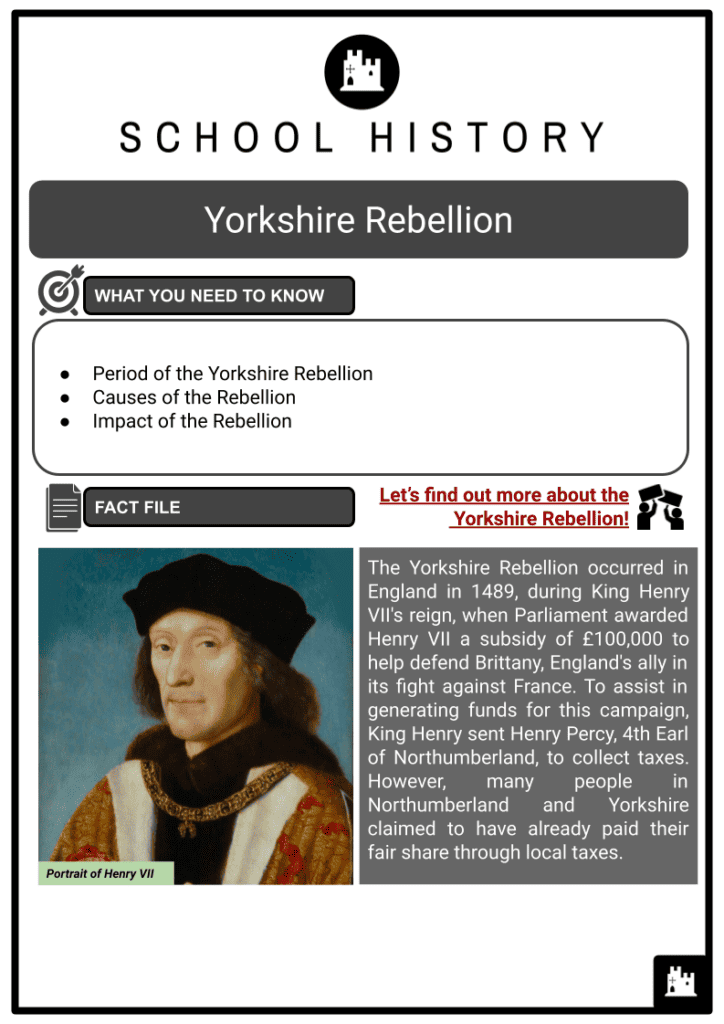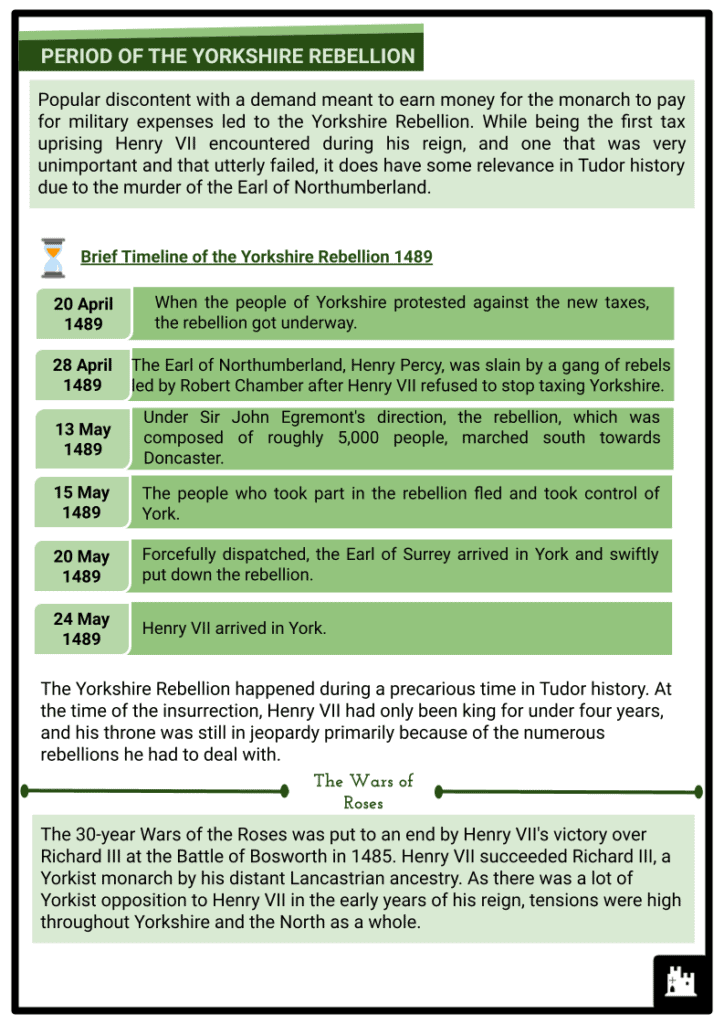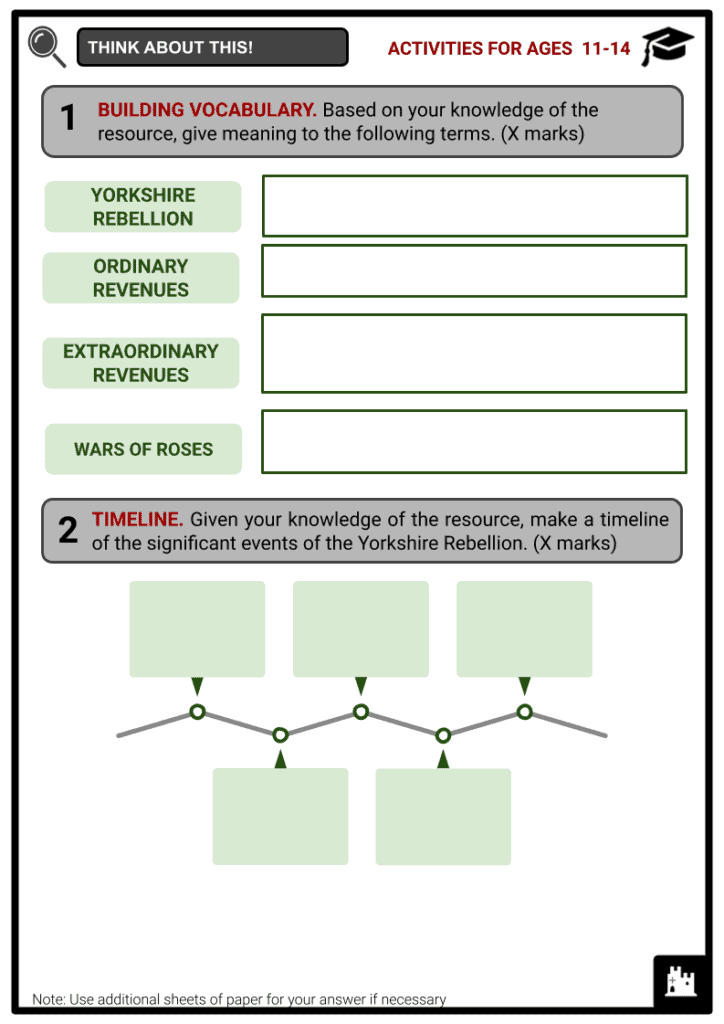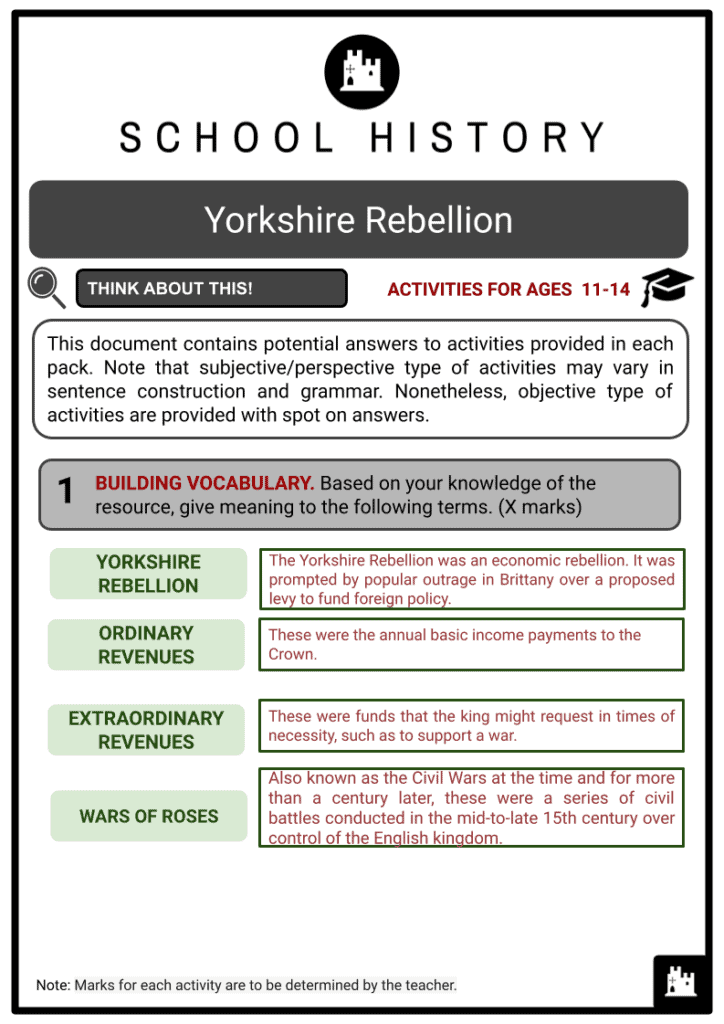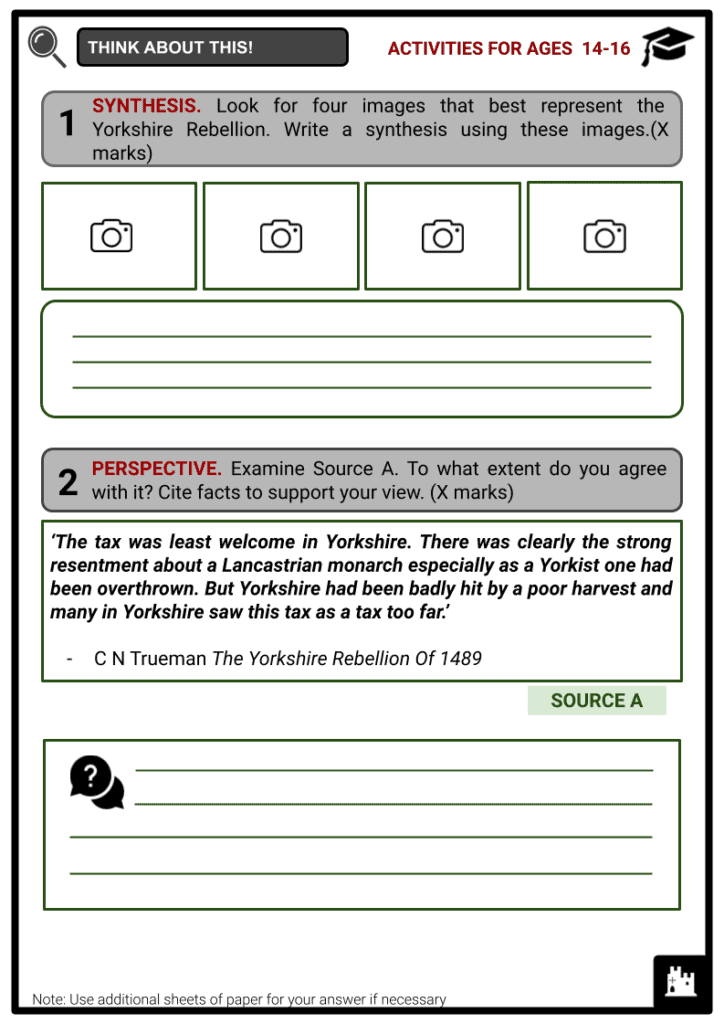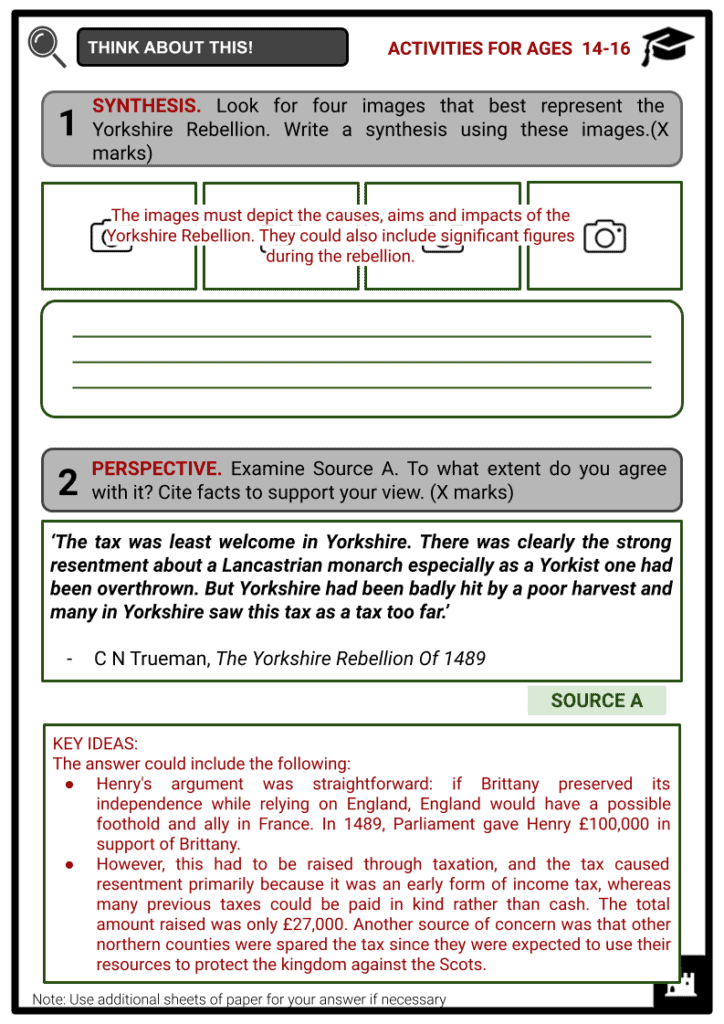Yorkshire Rebellion 1489 Worksheets
Do you want to save dozens of hours in time? Get your evenings and weekends back? Be able to teach about the Yorkshire Rebellion 1489 to your students?
Our worksheet bundle includes a fact file and printable worksheets and student activities. Perfect for both the classroom and homeschooling!
Summary
- Period of the Yorkshire Rebellion
- Causes of the Rebellion
- Impact of the Rebellion
Key Facts And Information
Let’s find out more about the Yorkshire Rebellion!
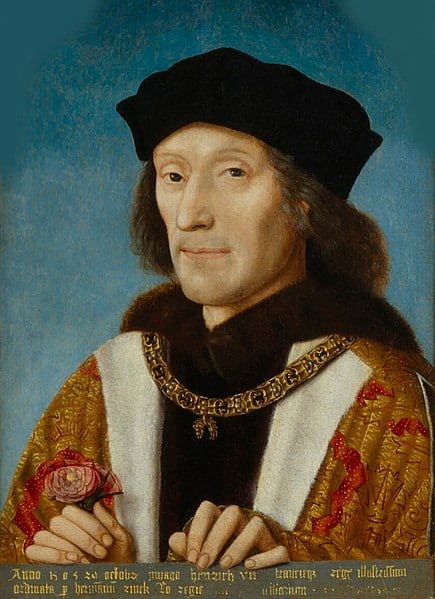
The Yorkshire Rebellion occurred in England in 1489, during King Henry VII's reign, when Parliament awarded Henry VII a subsidy of £100,000 to help defend Brittany, England's ally in its fight against France. To assist in generating funds for this campaign, King Henry sent Henry Percy, 4th Earl of Northumberland, to collect taxes. However, many people in Northumberland and Yorkshire claimed to have already paid their fair share through local taxes.
PERIOD OF THE YORKSHIRE REBELLION
Popular discontent with a demand meant to earn money for the monarch to pay for military expenses led to the Yorkshire Rebellion. While being the first tax uprising Henry VII encountered during his reign, and one that was very unimportant and that utterly failed, it does have some relevance in Tudor history due to the murder of the Earl of Northumberland.
Brief Timeline of the Yorkshire Rebellion 1489
- 20 April 1489. When the people of Yorkshire protested against the new taxes, the rebellion got underway.
- 28 April 1489. The Earl of Northumberland, Henry Percy, was slain by a gang of rebels led by Robert Chamber after Henry VII refused to stop taxing Yorkshire.
- 13 May 1489. Under Sir John Egremont's direction, the rebellion, which was composed of roughly 5,000 people, marched south towards Doncaster.
- 15 May 1489. The people who took part in the rebellion fled and took control of York.
- 20 May 1489. Forcefully dispatched, the Earl of Surrey arrived in York and swiftly put down the rebellion.
- 24 May 1489. Henry VII arrived in York.
- The Yorkshire Rebellion happened during a precarious time in Tudor history. At the time of the insurrection, Henry VII had only been king for under four years, and his throne was still in jeopardy primarily because of the numerous rebellions he had to deal with.
The Wars of Roses
- The 30-year Wars of the Roses was put to an end by Henry VII's victory over Richard III at the Battle of Bosworth in 1485. Henry VII succeeded Richard III, a Yorkist monarch by his distant Lancastrian ancestry. As there was a lot of Yorkist opposition to Henry VII in the early years of his reign, tensions were high throughout Yorkshire and the North as a whole.
- Henry VII, of Lancastrian ancestry, was anointed King of England. Five months afterwards, he wedded Elizabeth of York, effectively ending the Wars of the Roses.
- The Wars of the Roses was a decades-long conflict for English succession that culminated in the Battle of Bosworth Field in 1485, when King Richard III died, ending both the Plantagenets' reign and the English Middle Ages. The Tudors tried to consolidate English royal authority, which helped them avoid some issues plaguing the latter Plantagenet kings.
Claims of the Two Houses
LANCASTRIAN CLAIM
- The House of Lancaster was derived from Edward III's third surviving son, John of Gaunt. He inherited the title Duke of Lancaster from his wife, Blanche of Lancaster. Edward III gave the Lancastrian claim to the throne preference since it specifically underlined the male line of lineage.
YORKIST CLAIM
- The fourth living son of Edward III and younger brother of John of Gaunt, Edmund of Langley, was the ancestor of the House of York. Unlike the Lancastrian claim, the Yorkist claim to the throne was founded upon the female line of ancestry, as descendants of Lionel, the Duke of Clarence. The name came from Langley's major title as Duke of York, which he received in 1385 during the leadership of his nephew, Richard II.
- Many important leaders rose in power and afterwards failed to fulfill their duties because of deaths in battle, natural causes of death, executions, and possibly assassinations because the wars were intermittent engagements waged over three decades. Important generals like Warwick the Kingmaker also switched sides. Those favouring the Lancastrian dynasty over the competing House of York's claims to the throne were Yorkists. In addition to the Lancastrian claim to the throne, Lancastrians backed Henry VI, the king during that time, in fulfilling his duties and maintaining his power.
CAUSES OF THE REBELLION
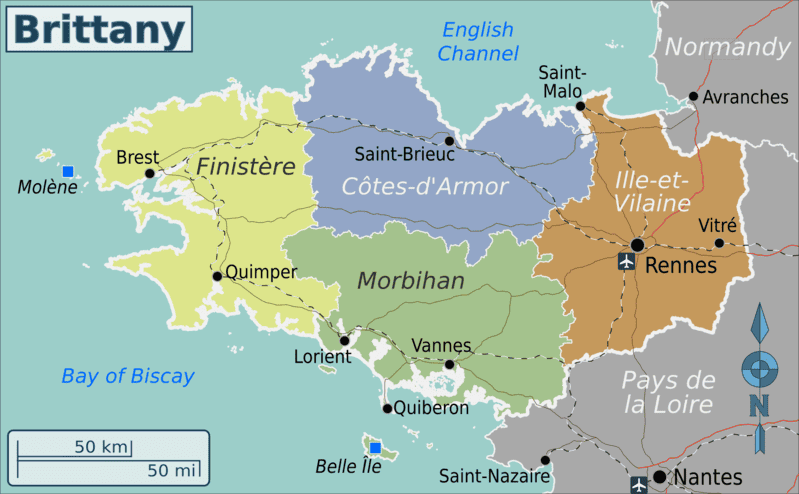
Henry VII decided to aid Brittany in its struggle to maintain its independence from France in 1489. He thought Brittany might be a valuable ally for England. Henry requested extraordinary resources to be obtained through taxes from Parliament to raise the 100,000 pounds he would need. During this time, an early version of an income tax was imposed on the people.
Types of Revenues
ORDINARY REVENUES
- These were the annual basic income payments to the Crown. They were derived through feudal levies, customs duties, judicial profits, and revenues from Crown estates. This was an annual collection that was seen as a kingly right.
EXTRAORDINARY REVENUES
- These were funds that the king might request in times of necessity, such as to support a war. He had to request them from Parliament, which then voted on whether or not to grant them. Extraordinary revenues were usually raised through taxes or loans if they were permitted.
SIGNIFICANT EVENTS OF THE YORKSHIRE REBELLION
- Although the Yorkshire Rebellion was modest and unsuccessful, two specific incidents stand out:
- The Earl of Northumberland's murder
- York City being taken over
- Because of these two events, a minor protest over taxes erupted into a fully fledged revolt, which alarmed Henry VII enough to travel to Yorkshire to forgive some of the rebels and end the uprising.
IMPACT OF THE REBELLION
- The Yorkshire Rebellion is notable because it demonstrates Henry VII's troubles in the early years of his reign. Furthermore, it stands out for the challenge it posed to the throne: unlike previous rebellions during his reign, this rebellion was economically motivated rather than due to problems with the Tudor dynasty.
- In this regard, it was a more 'typical' problem for Henry VII, as it was a tax rebellion that every monarch had to deal with to test their ability to govern. Henry VII's reaction to the uprising and his pardoning of many people who joined the rebellion were defining features of his early reign.
- Counterfeiting currency was a capital offence because coins were branded with the monarch's image, which must always remain under the monarch's absolute control.
- Following the rebellion, Henry frequently harshly punished only a few rebels, usually the leaders, while pardoning everyone else. Henry did this because he avoided being perceived as a cruel king, especially since his place on the throne was not yet entirely secure, and he was aware that future rebellions against him were possible. His effort was to establish the Tudor dynasty and consolidate his power.
- Because of the rebellion in Yorkshire, the Tudors considered their power to be based on their people's confidence in the absolute divineness of that power. In this environment, the implications of any uprising against royal authority, no matter how rapidly crushed, must be considered serious.
- The insurrection of Robert Chamber, a yeoman and the first leader of the rebellion who led the assassination of the Earl of Northumberland, did not spread beyond Yorkshire and appeared limited to the county's south- and northeast. Indeed, Henry VII's decision to hold court proceedings in York, the relatively small number of people charged with rioting, and Henry's leniency towards those on trial all indicate that Henry VII did not feel particularly threatened by the rebellion.

